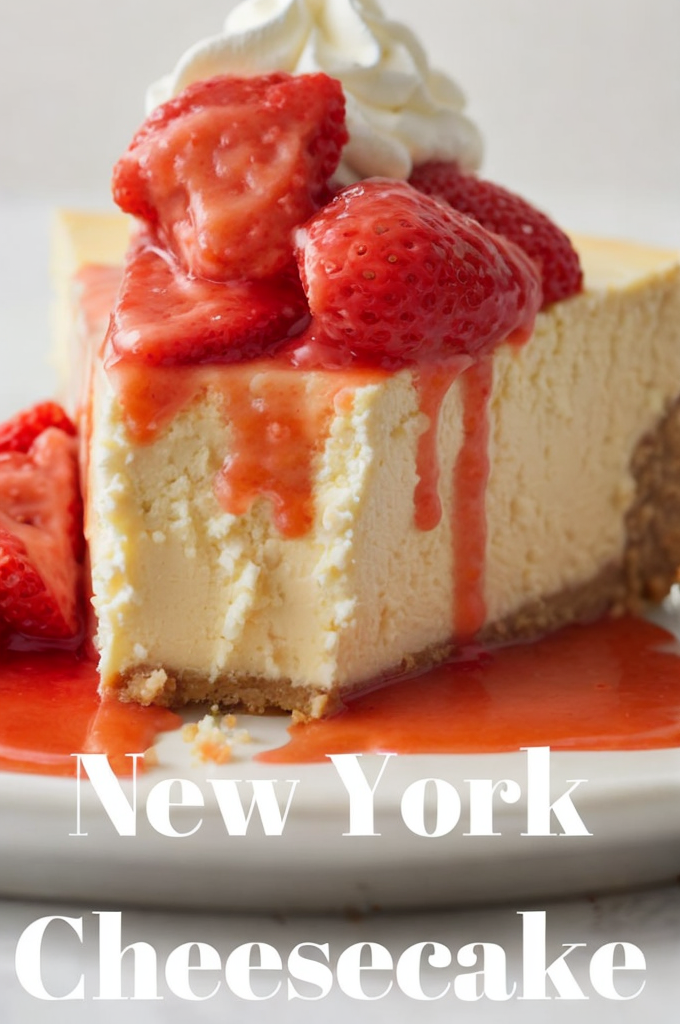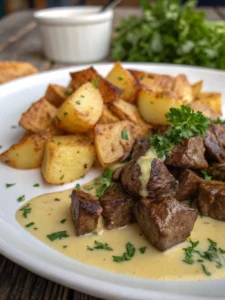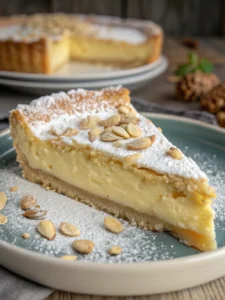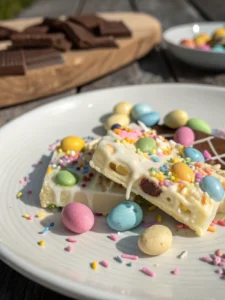Ultimate New York-Style Cheesecake: A Family Favorite Recipe
Experience the delightful indulgence of a classic Ultimate New York-Style Cheesecake, a true family favorite that never fails to please. This quintessential cheesecake recipe is the perfect combination of rich creaminess and a velvety texture, with a buttery crust providing the ideal contrast. Whether it’s a festive occasion or a weeknight treat, this cheesecake is bound to be the star of your dessert table.
A hallmark of New York-style cheesecake is its intense flavor, which derives from high-quality cream cheese. This recipe ensures a perfect balance of sweetness and tang, enhanced by the aromatic vanilla and lemon zest. The cheesecake’s aroma will captivate your senses, as it fills your kitchen with a heavenly scent while baking.
Quick Recipe Highlights
- Flavor Profile: Rich, creamy with hints of sweetness and a tangy undertone.
- Texture: Dense yet smooth, with a satisfying crumbly crust.
- Aroma: Inviting and warm with notes of vanilla and citrus.
- Visual Appeal: Perfectly set cheesecake with a lightly browned top.
- Skill Level Needed: Intermediate, with attention to detail and timing.
- Special Equipment: Springform pan, mixer, and a water bath setup.
Recipe Overview
- Difficulty Level: This recipe requires some baking skills, particularly for maintaining the right temperature and consistency while avoiding cracks.
- Category: Classic American dessert, perfect for any celebratory occasion.
- Cuisine: Rooted in New York culinary tradition, known for its bold flavor and texture.
- Cost: Moderate, primarily depending on cream cheese quality.
- Season: Best enjoyed year-round, particularly in cooler months for hearty satisfaction.
- Occasion: Ideal for birthdays, gatherings, and special seasonal holidays.
Why You’ll Love This Recipe
Indulge in the taste and texture that make the Ultimate New York-Style Cheesecake a dessert icon. The creamy filling melts in your mouth, perfectly offset by the crumbly, buttery crust. Every bite brings a harmonious blend of flavors, with vanilla’s sweetness and a citrus hint accentuating the richness.
Convenience is at your fingertips with this straightforward recipe. Although baking requires attention, the results are consistently exceptional. Prepare in advance to ensure it sets perfectly for your event. The process is an excellent opportunity to focus on the art of baking, enhancing your skills.
With nutritional advantages, this cheesecake can be adapted to various dietary needs. Control portion sizes to maintain balance, and experiment with low-sugar or gluten-free options for a guilt-free indulgence. This adaptability makes it a versatile recipe suitable for diverse preferences.
The social appeal of this cheesecake is undeniable. Serve it at gatherings and enjoy the compliments that follow. Its universally beloved taste acts as a conversational piece, inviting guests to savor and discuss flavors and textures, creating connections over shared indulgence.
From a cost perspective, this luxurious dessert is surprisingly accessible. With most ingredients readily available, you can achieve a gourmet experience without breaking the bank. It’s a testament to culinary elegance that doesn’t sacrifice quality for economy, making it a staple in any baker’s repertoire.
Historical Background and Cultural Significance
The Ultimate New York-Style Cheesecake is a tribute to American culinary heritage, tracing its origins to early Eastern European immigrants. As these communities integrated their traditional recipes, the beloved cheesecake evolved into the distinctive New York style known today.
Culturally, this cheesecake represents innovation within simplicity. It encapsulates the quintessential New York ethos: bold, unapologetic, and richly textured. The cheesecake has become a symbol of the city’s vibrant food scene, enjoying iconic status in desserts.
Through the years, the recipe evolved from a simple treat to a culinary masterpiece. Inspired by traditional recipes, modern adaptations incorporate new techniques and flavors, while preserving the fundamental elements that define New York-Style Cheesecake.
Regional variations exist, but the core attributes remain: a firm, creamy filling and a crust that complements its denseness. Though some variations might include different zest or toppings, the essence stays true to its roots, making each cheesecake uniquely New York.
Ingredient Deep Dive
Cream cheese is the heart and soul of New York-style cheesecake, bringing richness and superior texture. Its roots can be traced back to 19th-century European immigrants who popularized it in New York. Opt for high-quality, full-fat cream cheese to ensure an authentic cheesecake experience.
Lemon zest adds a fresh, tangy note that brightens the cheesecake’s flavor profile. It’s a source of vitamin C and antioxidants, contributing to overall health benefits. Choose unwaxed lemons for zesting, storing them in a cool, dry place for maximum freshness.
Vanilla extract is a key ingredient, lending a sweet yet mellow aroma to the cheesecake. Its cultural significance is profound, often regarded as a staple in dessert making for its enriching flavors. Store vanilla in a cool, dark space to preserve its robust aroma.
Eggs are crucial for the cheesecake’s structure, creating a smooth, stable filling. Fresh, high-quality eggs ensure a rich texture and enhance the nutritional profile. Look for eggs with a vibrant yolk, and store them in the refrigerator to maintain freshness.
Common Mistakes to Avoid
- Over-mixing the batter can introduce excess air, leading to cracks on the surface.
- Not using a water bath may result in uneven baking and cracked tops.
- Opening the oven door frequently can cause temperature fluctuations and impact the baking process.
- Skipping the cooling period can make the cheesecake too dense or unset.
- Using low-fat cream cheese can alter the texture, making it less creamy.
- Failing to wrap the pan properly may let water seep into the crust during the water bath.
- Not letting the ingredients reach room temperature can cause lumps in the batter.
- Ignoring the need to chill the cheesecake overnight can result in a soft, runny texture.
Essential Techniques
Master the art of the water bath, a technique crucial for even cooking and preventing surface cracks. Use a large pan with warm water, placing the springform in its center. Ensure no water spills over, and cover the pan exterior with foil for additional protection.
Proper temperature control is vital. Begin with preheating the oven and maintaining a stable temperature throughout baking. Use an oven thermometer to ensure accuracy, as even slight variations can impact the final result of your cheesecake significantly.
Handling the batter with care, mix ingredients until just combined. Over-mixing can lead to a denser texture, while under-mixing may cause an uneven bake. The goal is a smooth consistency, with all elements thoroughly and evenly incorporated.
Visual cues are key to knowing when your cheesecake is done. A slight jiggle in the center signifies it is ready, as it will continue to set as it cools. Overbaked cheesecakes will be firm and may crack due to excess cooking.
Pro Tips for Perfect Ultimate New York-Style Cheesecake
Achieve creamy perfection by using room temperature ingredients. This ensures even blending and smooth consistency, crucial for the perfect texture that New York-Style Cheesecake is renowned for.
Experiment with a hint of almond extract to introduce a nutty complexity and enhance the cheesecake’s existing flavors. This subtle twist will delight your taste buds and add a unique touch to the traditional recipe.
Invest in a high-quality springform pan to prevent leakage and enable easy removal. This ensures the cheesecake maintains its shape and elegance upon serving, elevating your presentation.
Use parchment paper to line the bottom of the pan, aiding in effortless transfer while eliminating the risk of the crust sticking to the base. Parchment also simplifies cleaning.
Allow your cheesecake to slowly cool in the oven with the door ajar after baking. This gradual reduction in heat prevents cracking and ensures a smooth, even texture throughout.
Chill the cheesecake overnight for a firm and flavorful finish. This patience-intensive step enhances the dessert’s depth of flavor, the hallmark of a New York-style masterpiece.
Variations and Adaptations
Combine classic New York elements with a twist of seasonal experimentation. Try adding pumpkin puree for an autumnal touch, merging two beloved flavors into one delightful dish that feels both fresh and familiar.
Modify the richness of this cheesecake into a low-carb treat by using sugar substitutes and almond flour for the crust. This maintains deliciousness while embracing dietary preferences, broadening the cheesecake’s appeal.
Explore culinary creativity with airy, mousse-like textures by folding in whipped cream into the filling. This variation provides a lighter alternative without compromising on the classic New York taste.
Transform your cheesecake with a marbled effect, swirling in chocolate or raspberry puree before baking. This eye-catching presentation couples with enhanced flavor, offering guests a visual and gastronomic feast.
Serving and Presentation Guide
Slice your Ultimate New York-Style Cheesecake with a warm knife for clean, sharp edges. Wipe the blade between cuts to maintain pristine presentation on each individual plate.
Garnish with seasonal fruits such as raspberries or strawberries to provide a vibrant color contrast and fresh flavor burst. This complements the richness of the cheesecake beautifully.
Pair with traditional accompaniments like whipped cream or vanilla sauce, adding a soft, creamy texture. Modernize with a drizzle of salted caramel or a sprinkle of toasted nuts for a gourmet twist.
Serve at a slightly cooler temperature, removing from the fridge 30 minutes before serving. This enhances the cheesecake’s flavors while allowing the texture to soften just perfectly for enjoyment.
Wine and Beverage Pairing
Pair your cheesecake with a light-bodied Riesling or Moscato to enhance the creamy, rich flavors with sweetness and a touch of acidity, perfectly balancing the cheesecake’s density.
For non-alcoholic alternatives, consider pairing with herbal teas like chamomile or mint, offering a refreshing contrast that keeps the palate invigorated and cleansed.
Enjoy the cheesecake alongside a robust, freshly brewed coffee to offset its sweetness, creating a delightful harmony through contrasting flavors and warmth.
Serve beverages at ideal temperatures: wines slightly chilled to enhance their fruity notes; coffee and tea freshly brewed for fullest taste experience. Pay attention to glassware to bring a sophisticated touch to your presentation.
Storage and Shelf Life
Store your cheesecake in an airtight container to maintain its texture and freshness. Avoid strong odors in the fridge, as cheesecake can absorb these, impacting the intended flavors.
Keep refrigerated at temperatures around 35-40°F for optimal shelf life, ensuring it remains fresh up to 1 week. Constant temperatures help retain the creamy consistency without deterioration.
Use a cake dome for storage if space permits, preventing any loss of moisture from the surface. The dome preserves its structure and overall aesthetic, maintaining an alluring presentation upon serving.
Monitor for signs of spoilage, like off odors or discoloration. Wrap slices individually for freezing, ensuring they are laid flat. This enables a longer life of up to 3 months, providing accessible indulgence for future enjoyment.
Make Ahead Strategies
To maximize convenience, prepare the cheesecake in stages. Make the crust and filling separately, assembling just before baking. This approach minimizes prep time without sacrificing quality.
Assemble the cheesecake a day or two ahead of your event, allowing it to mature in the fridge. Flavors deepen with time, presenting a richer experience for your celebration.
Reheat frozen slices by thawing in the fridge overnight. This gentle method prevents texture degradation, ensuring it remains as luscious as the day it was baked.
Finish with freshly whipped cream or citrus zest before serving, adding a fresh element to the presentation. These touches give the cheesecake a look of just being made, even days later.
Scaling Instructions
Halve the recipe for smaller portions, ideal for intimate gatherings. Use a smaller springform pan to maintain thickness and adjust baking time as necessary for consistent cooking.
Double the recipe for larger events, ideally using two individual pans to ensure even baking. Bear in mind the potential need for extra oven space and time to accommodate the extended volume.
Adjust equipment, such as using larger crisping racks when cooling doubled batches. Timing may alter slightly, but with caution, you can achieve a uniformly cooked and perfectly set cheesecake.
Consider storage implications when scaling. Plan enough fridge space, particularly if preparing in advance, avoiding overcrowding that could impact other stored food.
Nutritional Deep Dive
The indulgence of New York-Style Cheesecake offers a satisfying macro breakdown with fats providing energy and a sense of fullness, while carbohydrates and proteins round out this dessert’s profile.
Micronutrients, including riboflavin from cream cheese and choline from eggs, contribute to a beneficial nutrient intake. Enjoy in moderation for maximum pleasure within a balanced diet.
Portion control plays a crucial role in maintaining a balanced calorie intake. Opt for smaller slices to satisfy your sweet tooth while keeping aligned with health objectives.
For weight management, serve cheesecake paired with fresh fruits that introduce volume without excessive calories. The combination provides a full flavor experience with a lower caloric imprint.
Dietary Adaptations
For a gluten-free option, replace traditional crusts with nut-based alternatives like almond flour or crushed pecans, delivering a satisfying crunch without gluten presence.
Opt for dairy-free cream cheese and a coconut milk alternative to cater to lactose-intolerant guests. These substitutions maintain creamy texture while accommodating dietary needs.
To adapt this cheesecake to the vegan lifestyle, experiment with cashew or coconut-based cream cheese and egg alternatives like flaxseed meal, ensuring the structure remains firm and flavorful.
Embrace the low-carb trend by utilizing erythritol or stevia as sweeteners, reducing total carbohydrates while retaining the iconic New York-Style signature taste.
The Recipe
Ultimate New York-Style Cheesecake
Serves: 12
Prep Time: 30 mins
Cook Time: 1 hr 30 mins
Total Time: 2 hrs
Kitchen Equipment Needed
- Springform pan
- Electric mixer
- Large roasting pan
- Parchment paper
- Baking sheet
Ingredients
- 1.5 cups graham cracker crumbs
- 0.5 cup melted butter
- 1 cup sugar (divided)
- 2 lbs cream cheese, softened
- 1 tsp vanilla extract
- Zest of 1 lemon
- 4 large eggs
- 1 cup sour cream
Directions
- Preheat the oven to 325°F (165°C). Line the bottom of a 9-inch springform pan with parchment paper.
- Mix graham cracker crumbs, melted butter, and 2 tbsp sugar in a bowl. Press mixture firmly into the pan’s base to form the crust.
- In a mixer, blend cream cheese until smooth. Gradually add the remaining sugar, mixing well. Stir in vanilla and lemon zest.
- Add eggs one at a time, combining until just incorporated. Continue with sour cream, mixing to maintain a smooth consistency.
- Pour the filling into the prepared crust. Place springform in a large roasting pan, filling with hot water halfway up the sides of the baked pan.
- Bake for 90 minutes, checking for minimal jiggle in the center. Leave the cheesecake in the oven with the door ajar for an hour post-bake.
- Carefully remove from the water bath, then chill in the fridge overnight or at least 4 hours before serving.
Recipe Notes
- For an added flavor burst, incorporate a layer of fruit preserve between crust and filling.
- Freeze any leftovers in an airtight container for up to 3 months.
Troubleshooting Guide
Address any texture issues by avoiding excessive baking, which can lead to crack formation. Keep a close watch in the final 10 minutes and trust a slight jiggle as an indicator of doneness.
Ensure flavor balance by sampling ingredients like vanilla and zest before incorporation. Adjust subtly to prevent overwhelming citrus or vanilla notes that might mask the cheesecake’s essence.
Regulate temperature meticulously, leveraging an oven thermometer for precision. Uneven heating can cause undesired adjustments in the cheesecake’s internal structure and final mouthfeel.
For equipment challenges, any missing items like a springform pan can be remedied by lining standard pans with parchment for easy transfer.
Overcome ingredient substitutions by using high-quality alternatives, ensuring maintenance of the cheesecake’s distinct flavor profile and integrity without compromise.
Timing concerns? Prep crust in advance and refrigerate. This speeds up assembly while ensuring the crust remains fresh and ready for prompt filling.
Recipe Success Stories
Many enthusiasts have shared glowing feedback, attributing their success to following crucial techniques outlined—especially the use of a water bath, ensuring no-crack cheesecakes.
Some readers combined this recipe with seasonal elements, like incorporating pumpkin puree for Thanksgiving or peppermint extracts for Christmas—a demonstration of its versatility and adaptability.
Successfully adapted for gluten-free diets by replacing crust ingredients, the recipe retains its iconic status while accommodating dietary needs, proving its flexibility.
Photographers highlight that the stark contrast of the cheesecake against a dark background provides stunning visual results, emphasizing colors and textures for added aesthetic appeal.
Frequently Asked Questions
Q: Can I use low-fat cream cheese?
A: It’s possible but not recommended, as full-fat cream cheese ensures the rich and creamy texture essential for an authentic New York-style cheesecake. Low-fat alternatives might result in a softer texture and less intense flavor.
Q: What if my cheesecake cracks?
A: Cracking can often occur from overbaking or sudden temperature changes. If cracks appear, consider topping with whipped cream or fresh fruit, which can mask imperfections and add delicious layers of flavor.
Q: How do I know when my cheesecake is done?
A: Look for a firm edge and a slight jiggle in the center. It’ll continue to firm up as it cools. Monitor closely after the initial bake time, as overbaking leads to dryness and cracks.
Q: Can I make this cheesecake without a water bath?
A: Baking without a water bath risks uneven cooking and cracking. To succeed without one, bake at a reduced temperature and monitor the cheesecake carefully.
Q: What’s the best way to store leftovers?
A: Store slices in an airtight container in the fridge to retain freshness up to 1 week. For longer storage, wrap and freeze slices individually, protecting them from freezer burn and ensuring easy defrosting.
Q: Can I substitute sour cream?
A: Yes, you can use Greek yogurt as a healthier alternative, maintaining the cheesecake’s creamy texture while cutting down on fat content.
Q: How do I prevent the crust from becoming soggy?
A: Blind bake the crust for a few minutes before filling, ensuring it’s firm and less likely to absorb moisture from the filling during the baking process.
Q: Why is my cheesecake too dense?
A: Mixing the batter too much can introduce air, leading to a dense, heavy texture. Mix at a low speed and only until ingredients are combined for the best results.
Q: How can I make it more tangy?
A: Add an extra teaspoon of lemon juice or zest to the filling to enhance the tanginess. Adjust gradually while tasting to achieve the perfect balance.
Q: Is it possible to make a smaller cheesecake?
A: Certainly! Halve the ingredients and use a 6-inch springform pan. Adjust cooking times accordingly, checking for doneness around 60 minutes.
Additional Resources
Explore related recipes like a Lemon Curd Cheesecake or a No-Bake Cheesecake variant to expand your repertoire and delight your palate with new flavors and textures.
Dive into technique guides, focusing on mastering a graham cracker crust or perfecting your water bath setup. These skills translate across various desserts, broadening baking abilities.
Investigate ingredient insights such as vanilla’s aromatic profile or lemon zest’s brightening qualities, enhancing overall understanding and appreciation of culinary roles.
Consider equipment recommendations including standout springform pans, ensuring consistent results for all cheesecake adventures, solidifying your journey from novice to skilled baker.
Join the Conversation
Share your results on social media using custom hashtags, connecting with a community of fellow cheesecake enthusiasts. Engage through comments, feedback, and suggestions, fostering a shared love for exceptional baking.
Submit your cheesecake photos online and exchange photography tips and techniques. Capturing striking visuals reveals the delectable beauty of each slice, showcasing your culinary triumphs.
Write comprehensive reviews of the recipe, contributing valuable insights to aid others’ baking journeys. Discuss successes, challenges, and modifications to inspire other readers while establishing yourself as an engaged and informed community member.
Share unique adaptations and variations, propelling others to experiment. This cooperative spirit enriches the experience, creating an ever-evolving recipe that remains grounded in community enthusiasm and culinary passion.



